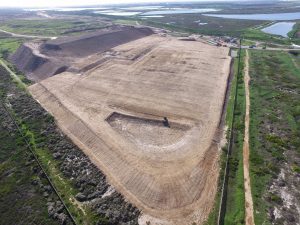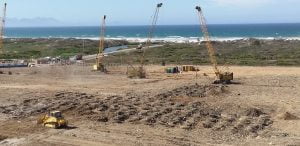The City of Cape Town and JG Afrika demonstrated their commitment to green and sustainable economic growth in the Western Cape by devising a means of re-using a landfill site for the development of a new state-of-the-art Materials Recovery Facility (MRF) and incorporating construction waste into its design.
Coastal Park MRF is the first to be located on an existing operational landfill site.

Constructing the facility on a 65 000m2 of land that was underlain by a 5m- to 6m-thick municipal solid waste deposit and covered by a sizeable building rubble stockpile required innovative and unique engineering solutions.
During the geotechnical investigation, undecomposed newspapers confirmed the age of the waste as being from the late 1980s. The municipal solid waste is not a well understood geotechnical material and is highly variable in nature, with the possibility of very different material properties over the entire development area.
The threat of differential settlements and long-term mechanical breakdown of the organic content of the waste body posed long-term settlement risks to any infrastructure built within or upon it.
Moreover, the generation of landfill gasses, such as methane can pose a fire and explosion risk throughout the infrastructure’s life cycle unless managed properly.
Excavating the waste and disposing of it on the operating landfill face and importing competent material would have reduced the landfill life by about 325 000 m3 and cost R21-million. This is in addition to the R55-million cost of importing competent new material to the project site.
Meanwhile, 20m high, 450 000m3 builder’s rubble deposit covered a sizeable portion of the site, with no available space to accommodate it. Transporting the rubble to another landfill site would result in additional costs of between R60-million and R70 million.
The builder’s rubble had been generated over the past five to eight years as part of an initiative to help prevent illegal dumping. The stockpiles consisted of variable construction waste, including large rocks, concrete, and building materials within a soil matrix.

Considering the sheer quantity of the material that overlay about 40% of the site, it was also impossible to measure the thickness of municipal solid waste beneath the stockpile to quantify the removal/shaping required to form the platform prior to tender. Financial variability to the contract due to quantity inconsistency therefore posed a significant risk.
A major challenge facing the design team was engineering the building platform, as well as supporting the foundation loads of the structures over a waste body.
The geotechnical engineers immediately ruled out the use of a stiffened waste body to support the foundation loads of the structures. This is considering the differential settlement risk, as well as the inconsistent nature of the material.
Any conventional foundations would, therefore, need to be founded on the underlying unconsolidated aeolian and beach sand deposits. This was an unacceptable solution, considering that they were located under the water table and trenching 5m through municipal solid waste material posed occupational health and safety risks.
It was, therefore, decided to support the building structure using single 600mm diameter piles in each footing position, as part of a piled foundation solution.
After investigating and researching possible solutions, it was decided to use the dynamic compaction ground improvement technique to support heavy vehicle traffic, ancillary structures, and services. This decision was based on its successful use globally to densify and stiffen material deposits, such as municipal solid waste in preparation for construction.
JG Afrika prepared a performance specification for the dynamic compaction, which entailed achieving a 150kPa bearing capacity across the entire site, with a stiffness modulus of at least 35MPa. This would be verified after compaction by a plate-load test and continuous surface wave testing. After conducting trials with different applied energies on site, the dynamic compaction contractor was able to ascertain the energy requirements to meet the design specification.

Considering the variability of the waste, it was also necessary to include 500mm engineered fill caps over the compacted waste with the earthworks design. The caps ranged from G7 to G5 in quality and comprises of a high strength geogrid to help distribute loading across the platform and mitigate any differential settlements experienced. This was then followed by the construction of the road or platform sub-base and base course.
In line with the principles of re-use, it was decided that the best way to address the problem posed by the large rubble stockpiles was to beneficiate it into a product that could be used in construction.
It was, therefore, specified that the builder’s rubble be crushed, screened, and processed into an engineered fill product and used in the layer and bulk earthworks.
Considering the variability in quality of the parent material, JG Afrika, as part of the preliminary design, conducted numerous tests from samples of crushed and processed material prepared from multiple locations on the stockpile that had been produced by the crushing contractor.

The results showed that it would be possible to produce up to a G5 quality material by carefully selecting and prioritising certain areas of the stockpile by the contractor. Based on the quality study conducted, a decision was also taken to prioritise the use of beneficiated processed rubble in the capping of the existing landfill embankments, in addition to undertaking screening and stringent quality checks during construction.
This approach provided significant savings in transporting the material to a different site and in the procurement of material from traditional commercial sources for use in the earthworks – even after considering the cost of overseeing the quality of material that was produced from the stockpile by the contractor.
An innovative gas vent system was also designed to ensure that landfill gas does not build up and pose a risk to the Coastal Park Integrated Waste Management Facility and its operations. It incorporates drilling relief wells across the site, allowing a preferential path for gas release. The wells are linked by a collection pipe just beneath the surface of the dynamically compacted waste, which leads to a typical “whirly bird” extraction fan. This ensures a negative pressure to draw the gas to the surface and vent it to the atmosphere. There is also an option to extend this to the gas collection system, should the gas yield be strong enough to warrant this.

The City of Cape Town has identified the stimulation of the recycling and waste industries as a critical component of a sustainable economy, and the construction of the Coastal Park MRF is a key statement of this intent.
Any design for such a facility would need to reflect these principles. JG Afrika was able to produce innovative and sustainable solutions to this unique and interesting engineering challenge.
Notably, the project also demonstrates that innovative solutions are found when companies work with government to solve South Africa’s unique socio-economic-challenges.
